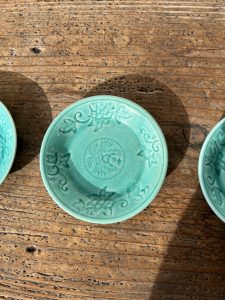本日2月29日、うるう年です。(愛知県名古屋市千種区姫池通 骨董品買取 古美術風光舎)
2024.02.29
みなさまこんにちは、スタッフYでございます。

本日は2月29日ですね。そう、今年はうるう年。
4年に一度しか自分は気に留めないような気がしまして、本日は「うるう年」についての小ネタを仕入れてみました。一息つきたい時にご一読ください。
もともと「閏(うるう)」という言葉自体には、「平年よりも日数や月数が多い」という意味がありまして、つまり「閏年(うるう年)」とは、「閏のある年」。平年よりも1日、日付が多くなる年のことを、うるう年と言います。
現在、世界で広く使われているのは、地球が太陽の周りをまわる周期をもとにした「太陽暦」。しかし、地球が太陽の周りを1周するのにかかる日数はピッタリ365日ではなく、365日よりおよそ1/4日長い365.2422日(365日5時間48分46秒)なのですが、このことは紀元前から天体観測で発見されており、その補正を行う必要があって設けられたのが、うるう年なのであります。
そんなうるう年、歴史はなんと紀元前までさかのぼります。紀元前45年からローマの英雄ユリウス・カエサルによって「ユリウス暦」が導入されていたのですが、それまでに使われていたのは、1年を355日とした「ヌマ暦」。ですが、責任者の怠慢などでうるう月の挿入が正しく行われなかったことなどから、暦と実際の季節が合致しない事態に陥ってしまいます。
そこで、ユリウスが「平年を365日」とするユリウス暦で暦の改革を行いました。このときのユリウス暦に、4年に1度のうるう年も制定されております。
このころ、まだ日本ではたぶん暦なんて概念もなく、ただぼにやりと太陽を眺めていたひとがほとんどだったような時代の気がして、その文明の格差をひしひしと感じますね。
また、そんなうるう年、英語では「leap year(リープ・イヤー)」と言うようです。「leap」には「跳ぶ、跳ねる」という意味があるようで、たとえば、平年の場合は、2021年1月1日は金曜日、翌年の2022年1月1日は土曜日という具合に、同じ月日を見ると、翌年はひとつ先に進んだ曜日に当たります。
しかしうるう年の場合は、翌年の曜日が2つ先に進むこととなります。たとえば、2020年1月1日は水曜日ですが、2021年1月1日は金曜日でした。そのように、曜日がひとつ先に飛ぶことから、「leap year」という名前がついたのではないか、と言われています。面白いですね。
また、「ユリウス暦」で4年に1度のうるう年が制定されたことを紹介しましたが、長い長い年月を経ていくと、暦と季節にズレが生じ、やがてそれが無視できないレベルにまで到達します。そこで、ローマ教皇グレゴリウス13世が、地球が太陽をまわる時間を「365日よりわずか0.2422日だけ長い」ことを天体観測で実証し、1582年、現在も使われている「グレゴリオ暦」に改暦しております。このグレゴリオ暦では、うるう年を次のように定めています。(1)西暦が4で割り切れる年をうるう年とする(2)西暦が100で割り切れて、400で割り切れない年は、平年とする
2020年や2024年は(1)に当てはまるので、うるう年となりますが、2100年、2200年、2300年は(2)に当てはまり、うるう年にはなりません。また、2000年や2400年は100で割り切れますが、400でも割り切れるため、うるう年となるそうです。
また、補正が必要となる時間が0.25日ではなく、0.2422日だったため、うるう年を「4年に1度」挿入するだけでなく、それ以外にわずかな補正が必要となったようでして、「4年に1度のオリンピック開催年がうるう年」と単純にならないのは、このような理由があるようでして、確かに地球と太陽の動きをきちんと暦に合わせるためにその誤差の扱いは難しいところではありますね。
ところで、たまに2月29日が誕生日の方がいらっしゃるのですが、誕生日をいつ祝っているのか気になります。前倒しにしたりそもそも出生届の日付を変更しているのでしょうか。
本日は4年に一度のジャスト誕生日ですので、本日お誕生日のみなさま4年分を盛大に祝ってほしいものです。
それではごきげんよう。

Hello everyone, this is Staff Y.
Today is February 29. Yes, this year is a leap year.
I feel like I only pay attention to it once every four years. Please read it when you want to take a break.
Originally, the word “leap” itself means “more days or months than in a normal year,” and a leap year is a year with a leap. A leap year is a year in which one more day is added than in a normal year.
The solar calendar, which is based on the cycle of the earth’s orbit around the sun, is widely used in the world today. However, it takes 365.2422 days (365 days, 5 hours, 48 minutes and 46 seconds), which is a quarter of a day longer than 365 days, for the earth to make one full revolution around the sun, This was discovered by astronomical observations since BC, and the leap year was established to compensate for this fact.
The history of leap years dates back to 45 B.C., when Julius Caesar, a Roman hero, was born. The Julian calendar was introduced in 45 B.C. by Julius Caesar, a Roman hero, but the Numa calendar, which had 355 days in a year, was used until then. However, due to negligence on the part of those in charge, the leap month was not inserted correctly, resulting in a situation where the calendar and the actual seasons did not match.
Therefore, Julius reformed the calendar with the Julian calendar, which set the normal year at 365 days. The Julian calendar at that time also established a leap year once every four years.
At that time, most people in Japan probably did not have the concept of a calendar and were just gazing at the sun in a daze, and I feel the gap in civilization very keenly.
In English, such a leap year is called a “leap year. For example, in a normal year, January 1, 2021 falls on a Friday and January 1, 2022 falls on a Saturday.
However, in the case of leap years, the following year’s day of the week is advanced by two. For example, January 1, 2020 is a Wednesday, but January 1, 2021 is a Friday. It is said that the name “leap year” may have come from the fact that the day of the week jumps ahead one day. Interesting.
I also mentioned that a leap year was established every four years in the “Julian calendar,” but over the long, long years, a discrepancy between the calendar and the seasons occurs, and eventually it reaches a level that cannot be ignored. Pope Gregory XIII, however, demonstrated through astronomical observations that the earth’s orbit around the sun was only 0.2422 days longer than 365 days, and in 1582 the calendar was changed to the “Gregorian calendar,” which is still in use today. In the Gregorian calendar, leap years are defined as follows (1) A leap year is a year in which the western calendar is divisible by 4. (2) A leap year is a year in which the western calendar is divisible by 100 and not divisible by 400.
In addition, since the time that needed to be corrected was 0.2422 days instead of 0.25 days, it seems that not only did a leap year need to be inserted “once every four years,” but also a slight correction was required. It is true that it is difficult to handle the error in order to properly adjust the movement of the earth and the sun to the calendar.
By the way, there are people whose birthdays are on February 29 sometimes, and I am wondering when they celebrate their birthdays. Do they move it forward or change the date on their birth certificate in the first place?
Today is just a once-every-four-years birthday, so I hope that everyone who has a birthday today will celebrate it in a big way for the past four years.
Have a good day.
*******************
ご実家の整理やお片付けなどをされている方のご相談などが多くございます。
お片付けなどくれぐれもご無理のないようになさってくださいませ。
風光舎では古美術品や骨董品の他にも絵画や宝石、趣味のお品など様々なジャンルのものを買受しております。
お片付けをされていて、こういうものでもいいのかしらと迷われているものでも、どうぞお気軽にご相談下さいませ。
また風光舎は、出張買取も強化しております。ご近所はもちろん、愛知県内、岐阜県、三重県その他の県へも出張いたします。
まずは、お電話お待ちしております。
愛知県名古屋市千種区姫池通
骨董 買取【古美術 風光舎 名古屋店】
TEL052(734)8444
10:00-18:00 OPEN

